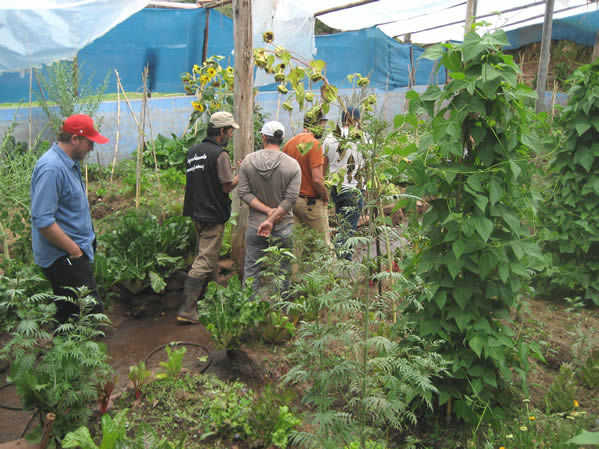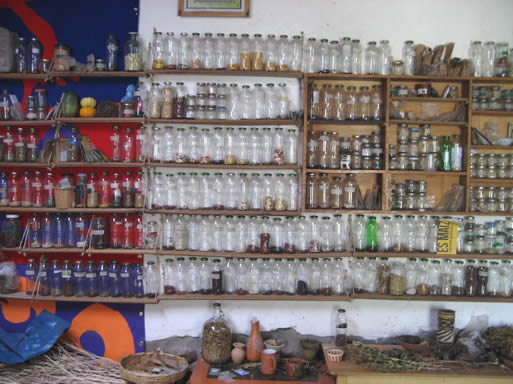A Reunion of Biointensive Farmers in the Sacred Valley of Peru (continued)
Touring the in-ground swimming pool Biointensive mini-farm at Arariwakuna The project consists of a Biointensive demonstration mini-farm, a seed bank that houses over 1,000 varieties of seeds, and a restaurant that serves traditional Incan food (including a breakfast fava bean soup-drink that is delicious!). The name of the seed bank is Casa de Semillas (House of Seeds). We were astonished to realize Alain and his family had accomplished so much in such a short time. They have converted an in-ground swimming pool into a greenhouse, established the restaurant with a veranda made of cob for serving, created a community soccer field and built a beautiful stone and cob house.
The seed collection at Arariwakuna Casa de Semillas Later that afternoon we sat with Alain as he shared how the model of traditional Incan society has an important role to play in organizing and empowering campesinos who are struggling to maintain their traditional ways. According to Alain, in this ancient model, those who work the land are most prized and respected. He went on to explain how the Inca grew mani (the peanut plant) and how this crop symbolized the structure of Incan society. The peanut is the seed of the mani. As the mani plant matures, peanuts are formed underground in a radius off the main roots of the plant. The nuts are seeds which will go on to form plants of their own. This outwardly branching growth pattern forms networks which perpetuate the ecosystem around the plant, in the same way the small Incan communities were connected to the larger centers of Incan culture and connections were maintained through networks of communication and trade. Many of the priest class of Incan society were found buried with gold and silver peanuts or jewelry containing peanut symbolism. When I asked Alain how he sees campesino culture returning to this resilient form of community, he responded with a smile, stating, "This is the role of Casa de Semillas: the seeds and saving of seeds spread just like mani, and the basis of our culture is seeds, without which we do not have life, the sharing of food or the structure of community." The next day we visited the area of Tippon, the site of an ancient agricultural station similar in function to Moray. This is the place Alain had seen in his dreams. We hiked a network of ancient ruins linked by small aqueducts which strikingly reminded me of the mani conversation we had had the day before. These aqueducts ran in perfectly constructed channels from the ridges of the mountains to small communities perched on the cliffs. Often these channels then branched off into individual structures which seemed to be sites for communal use and ceremony. Again, the architecture was amazing—the stonework absolutely perfect. After we came around a beautiful set of ruins, the view opened up to the valley of Tippon below. As we walked the ruins, Alain excitedly greeted each of the docents, and they laughed together as Alain declared he was going to start growing food and seed here again. The docents were local community members who once farmed the terraces before the government expropriated the site and declared it no longer suitable for farming, only tourism. They gave the community members a choice—to work as docents to oversee the care of the ruins, or to leave with nothing. Most chose to stay and be docents. The terraces, seeded with perennial grass, are maintained by mowing, and the thousands of tourists each year are walking all over the ancient soils, compacting them and destroying the soil structure so carefully created and maintained over hundreds of years. After a long night of storytelling and music, the goodbyes the following morning were bittersweet. Alain had so graciously offered his time, hospitality (and seeds!), and he had much work to get back to. We had to return to Cusco to catch our flights. As I look back, I realize that throughout our travels in Peru the people we met and worked with shared a common vision—the need to care for soil and resources, save seeds, and return a sense of dignity to campesino culture which has for millennia subsisted on protecting the land. As changing times bring new generations to carry on these traditions, a great gap exists. There is a similar gap here in America, where the average age of our farmers is 58. As a human race we must ask the question, who will care for our soil, water, and seeds? We have to—you and I. After all, we are all dependent on our Mother Earth and we all share the responsibility of honoring the great work ahead—a work more ancient than the Inca, full of color and joy and the celebration of life. It was an honor to travel with my friends whom I view as heroes in their own right. We have already decided to make a similar trip annually, and next year we are heading to Oaxaca to visit some of the Biointensive projects in that region, collect seeds and of course sample some of the locally distilled spirits. My traveling companions and I want to extend endless gratitude to those who took care of us on our trip—Julio, Yessica, Alain and all of the campesinos who took a moment from their work to share stories of life and work. May we all travel well!
Go to Page: 1 | 2 top | Newsletter Home |Table of Contents| Archive
|




